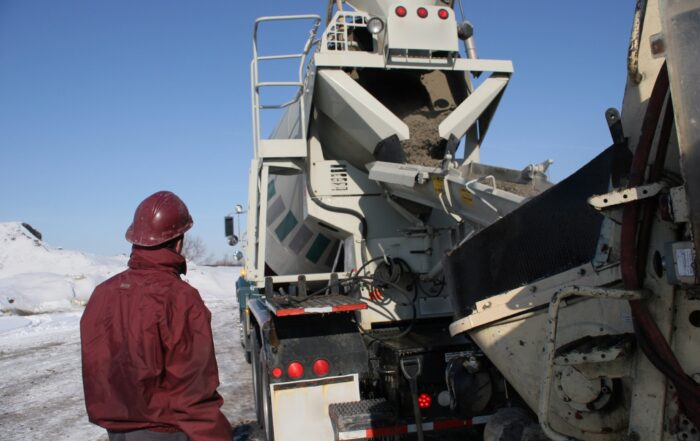The basic things to know about concrete.
Although the terms cement and concrete are often used interchangeably, cement is an ingredient of concrete. Concrete is a mixture of aggregates and paste. The aggregates are sand and gravel or crushed stone; the paste is water and portland cement. Portland cement is not a brand name, but the generic term for the type of cement used in virtually all concrete, just as stainless is a type of steel. Cement comprises from 10 to 15 percent of the concrete mix, by volume. Through a process called hydration, the cement and water harden and bind the aggregates into a rocklike mass. This hardening process continues for years meaning that concrete gets stronger as it gets older.
Curing is one of the most important steps in concrete construction. Proper curing greatly increases concrete strength and durability. Concrete hardens as a result of hydration: the chemical reaction between cement and water. However, hydration occurs only if water is available and if the concrete’s temperature stays within a suitable range. During the curing period-from five to seven days after placement for conventional concrete, the concrete surface needs to be kept moist to permit the hydration process. New concrete can be wet with soaking hoses, sprinklers or covered with wet burlap, or can be coated with commercially available curing compounds, which seal in moisture. Concrete can also be poured in colder temperatures if cured correctly.
Air-entrained concrete contains billions of microscopic air cells per cubic foot. These air pockets relieve internal pressure on the concrete by providing tiny chambers for water to expand into when it freezes. Air-entrained concrete is produced through the use of air-entraining portland cement, or by the introduction of air-entraining agents, under careful engineering supervision as the concrete is mixed on the job. The amount of entrained air is usually between 4 and 7 percent of the volume of the concrete, but may be varied as required by special conditions.
- For garages, carports and any exterior flatwork that will be troweled, keep air in the low range – close to 5%. This will help reduce “crusting“ of the surface and blistering.
- For exterior flatwork that will not be troweled (broomed, exposed, etc.), keep air around 6% for freeze-thaw durability.
- For interior flatwork that will be troweled, keep air around 4%. This will help control bleeding and not cause blistering.
MPa Concrete Strength
| Concrete Location | BCBC Minimum Strength (MPa) | BCBC Maximum W/C* Ratio | BCBC Air Content | Suggested Strength (MPa) | Maximum W/C Ratio | Optimum Air Content Range |
| Footing, walls, foundations | 15 | 0.70 | n/a | 20 – 25 | 0.55 – 0.60 | 3-5% |
| Interior flatwork | 20 | 0.65 | n/a | 25 -28 | 0.50 – 0.55 | 3-5% |
| Garages, carports | 32 | 0.45 | 5-8% | 32 | 0.45 | 5-6% |
| Exterior flatwork | 32 | 0.45 | 5-8% | 32 | 0.45 | 5-7% |
Concrete, like all other materials, will slightly change in volume when it dries out. Translated into dimensions, this is about 1/16 of an inch in 10 feet (.4 cm in 3 meters). The reason that contractors put joints in concrete pavements and floors is to allow the concrete to crack in a neat, straight line at the joint when the volume of the concrete changes due to shrinkage.
Concrete hardens and gains strength as it hydrates. The hydration process continues over a long period of time. It happens rapidly at first and slows down as time goes by. To measure the ultimate strength of concrete would require a wait of several years. This would be impractical, so a time period of 28 days was selected by specification writing authorities as the age that all concrete should be tested. At this age, a substantial percentage of the hydration has taken place.
Portland cement is a hydraulic cement which means that it sets and hardens due to a chemical reaction with water. Consequently, it will harden under water.
The easiest way to add strength is to add cement. The factor that most predominantly influences concrete strength is the ratio of water to cement in the cement paste that binds the aggregates together. The higher this ratio is, the weaker the concrete will be and vice versa. Every desirable physical property that you can measure will be adversely effected by adding more water.
This is a very complex question. And it depends on what elements are being measured. Often people interchange the words “cement” and “concrete”. But Portland cement is only one of the ingredients that make up concrete. Because cement gets quite a bad rap – because of its carbon dioxide emissions – it is often thought that concrete is not a green building material. But the end product of the manufacture of concrete presents a very green building alternative. Concrete is sustainable and because it is long-lasting, energy efficient and versatile, recyclable, it can help builders achieve LEED certification. Concrete is the foundation of modern life. Combined with steel, it is what holds up buildings, keeps dams from splitting open, and our electrical grid intact. But like everything, concrete needs to be used correctly and in harmony with nature.
Hyland Ready Mix News
Hyland Concrete Technical Bulletin – Pouring ready mix in hot weather
Hot Weather Concreting Considerations for Standard Concrete Applications What is considered hot weather? As per CSA A23.1-7.1.1 hot weather concreting occurs when the ambient ....Read More >>
The right way to pour concrete in cold weather
Build your winter concrete projects Whether you are a commercial contractor building a winter project, or a homeowner improving your property outdoors, the colder Vancouver ....Read More >>
The Comox Valley Water Treatment Plant – A year in review
This fall the Comox Valley Water Treatment plan celebrated one year of the construction completion. We thought it would be a great idea to ....Read More >>



